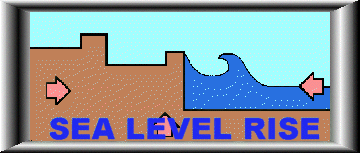
The Effects of Groins on Beaches
-
Rationale/Objectives/Purpose:
-
Students will observe the effect of groins on beaches via an outdoor,
hands on activity.
-
Time Required:
-
1 class period
-
Safety Issues:
-
No Safety Issues
-
Materials:
-
For every 5 students:
-
4 buckets or large containers
-
2 plastic cups
-
sand (or other material such as packing popcorn or soil)
-
whistle
-
Procedures:
-
Separate the students into groups of 5.
-
Have three of the students lie down on the ground, parallel to each
other, with approximately 10 feet between them.
-
Take two filled buckets and place one filled bucket on each side of
the student in the center, near his/her feet. Place one bucket to the right
of the first student. Place the last bucket to the left of the last student.
-
Give each of the remaining two students a plastic cup and tell them
to stand next to a bucket that is to the right of the "student groins"
-
Explain to the students that, when you blow the whistle you are representing
a wave breaking against the shore and they will represent the current moving
the sand along the beach. The students on the ground are representing groins.
-
Now, blow the whistle. Students should scoop up a cupful of sand from
the bucket on their left and transfer it to the bucket on their right and
then return with an empty cup to their starting point.
-
Continue this process at least 5 times.
-
Students should observe that the bucket to the left of the "student
groin" is filling, while the bucket to the right is emptying. (You may
wish to do this more than 5 times depending on the size of your containers
and cups.)
-
You may want to have the standing students trade places with the ones
on ground so that they can observe what is happening with the groins in
their proper places.
-
Click here to see setup diagram.
-
Assessment:
-
Possible assessments include:
-
Have students answer the worksheet questions.
-
Have students write up their observations in paragraph form.
-
Have students discuss in small or large groups what they observed and what
they would do to solve this problem.
-
Have students do research projects or posters on beach erosion and restoration.
-
Teacher Background/Extensions:
-
This can be done either as a teacher demonstration or as a hands-on
activity with students working in groups.
-
Background: Many beach communities have regular ongoing beach restoration
activities such as "sea oat planting days". Have the students check with
the local chamber to find out if such an activity exists in your community.
If not, consider starting one. Beach cleanups are also successful ways
to involve students in a beach community. There are many laws governing
the use of groins and the protection of vegetation such as sea oats and
mangroves. Have students research these laws.
Humans try many ways to prevent or slow down beach erosion. Groins,
usually built in groups known as "groin fields" perpendicular to the shore,
trap sand between th placing large amounts of sand onto an eroded beach
to bring the beach profile up to a more desirable level. After the intial
fill, the process must periodically be repeated. This is known as renourishment.
Seawalls are built at the land's edge to resist the waves. A seawall
can actually speed up erosion as sediment is scoured away at its base.
-
Beach
Erosion Lesson Plan
General info
Exercises
related to coastal loss
Key words:
groins, erosion, beach, breakwaters, seawalls, currents, deposition
